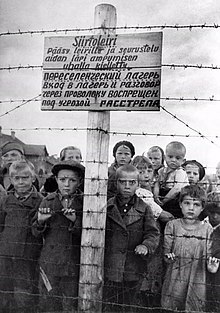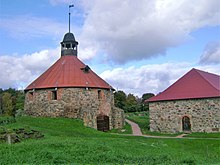Republic of Karelia
Context of Republic of Karelia
The Republic of Karelia, also known as just Karelia (Russian: Каре́лия, Ка́рьяла; Karelian: Karjala), is a republic of Russia situated in Northwest Russia. The republic is a part of the Northwestern Federal District, and covers an area of 172,400 square kilometres (66,600 square miles), with a population of 533,121 residents. Its capital is Petrozavodsk.
The modern Karelian Republic was founded as an autonomous republic within the Russian SFSR by the Resolution of the Presidium of the All-Russian Central Executive Committee (VTsIK) on 27 June 1923 and by the Decree of the VTsIK and the Council of People's Commissars of 25 July 1923, from the Karelian Labour Commune. From 1940 to 1956, it was known as the Karelo-Finnish Soviet Socialist Republic, one of the republics of the Soviet Union. In 1956, it was once again made an autonomous republic and remained part of Russia following th...Read more
The Republic of Karelia, also known as just Karelia (Russian: Каре́лия, Ка́рьяла; Karelian: Karjala), is a republic of Russia situated in Northwest Russia. The republic is a part of the Northwestern Federal District, and covers an area of 172,400 square kilometres (66,600 square miles), with a population of 533,121 residents. Its capital is Petrozavodsk.
The modern Karelian Republic was founded as an autonomous republic within the Russian SFSR by the Resolution of the Presidium of the All-Russian Central Executive Committee (VTsIK) on 27 June 1923 and by the Decree of the VTsIK and the Council of People's Commissars of 25 July 1923, from the Karelian Labour Commune. From 1940 to 1956, it was known as the Karelo-Finnish Soviet Socialist Republic, one of the republics of the Soviet Union. In 1956, it was once again made an autonomous republic and remained part of Russia following the dissolution of the Soviet Union in 1991.
More about Republic of Karelia
- Population 609071
- Area 172400
- This article relies largely or entirely on a single source.Read lessThis article relies largely or entirely on a single source. (November 2021)Middle agesKorela Fort
The Karelian people and culture developed during the Viking Age in the region to the west of Lake Ladoga. Karelians were first mentioned in Swedish sagas around the 10th century. Russians first mentioned Karelians in 1143, they called Karelians "Korela".[1]
Sweden's interest in Karelia began a centuries-long struggle with Novgorod (later Russia) that resulted in numerous border changes following the many wars fought between the two, the most famous of which is the Pillage of Sigtuna of 1187. In 1137 the oldest documented settlement was established, the modern-day city of Olonets (Aunus).[2] Karelians converted to Orthodox Christianity in 1227.[3] The Karelians' alliance with Novgorod developed into domination by the latter in the 13th century, when Karelia became a part of Novgorod under the name of Obonezhie pyatina as an autonomy. Later Karelia had anti-Novgorod revolts in the 13th and 14th centuries.
Later Karelia became a part of Muscovy when Novgorod was annexed in the second half of the 15th century.
During the Great Northern War (1700–1712) the modern-day capital of Karelia, the city of Petrozavodsk was founded as a cannon factory by Peter the Great.[4]
19th centuryOn September 9(21) 1801 Olonets Governorate was created by order of Alexander I.[5]
Early 20th century Union of White Sea Karelians
Union of White Sea KareliansIn 1906 the Union of White Sea Karelians (Vienan karjalaisten liito) was created; it advocated for equal rights for minorities and democratization.[6] It stopped existing in 1911 after its leaders were deported to Siberia. It later influenced Karelian intelligentsia which led to the creation of the Uhtua Republic.
In 1918 White Karelia declared independence from Russia, creating the Uhtua Republic. In 1920 Finnish forces in the south occupied Olonets, creating a puppet government, which was crushed by the Red Army in the same year. The Republic of Uhtua was crushed in December 1920.
Soviet Karelia Sandarmokh forest
Sandarmokh forestOn June 8, 1920 Karelian Labour Commune was created. In 1921 an insurrection was started as a last attempt to restore the Uhtua Republic, but it was crushed by the Red Army, many Karelian, Finnish, and some Russian families left for Finland with only some returning to Soviet Karelia, they were later repressed under Stalin.[7] In 1923, the KLC became the Karelian Autonomous Soviet Socialist Republic (Karelian ASSR).
In the 1930s Finnish communists, who fled to Karelia, were purged. People of Finnish and Karelian nationality were also subject to repressions. Despite being 3% of the population, over 41% of all repressed in Karelia were Finns, 27% were Karelian, and 25% were Russian.[8] Karelia has one of the biggest burial sites of Stalinist purges in Russia – Sandarmoh, where possibly thousands of victims were executed.
Winter WarDuring the Winter War, a Soviet puppet government was created in occupied territories. The Finnish Democratic Republic was to incorporate most of Finland's pre-war territories plus some western parts of the KASSR. Some members of the FDP government were also members of the KASSR government.[9]
 Evacuation from Kurkijoki, near Lahdenpohja
Evacuation from Kurkijoki, near LahdenpohjaAfter the Moscow Peace Treaty territories of the Karelian Isthmus were transferred to the newly created Karelo-Finnish Soviet Socialist Republic. After the evacuation of Finnish Karelia, the new territories were left unpopulated, so migrants from Belarus, Ukraine, Russia, and other Soviet republics moved in. To this day, this area has one of the lowest percentages of Karelian and Finnish populations in the Republic.
World War IIAfter the beginning of World War II, mass rallies were held on the territory of the republic, at which the inhabitants of Karelia declared their readiness to stand up for the defense of the Soviet Union. Workers of the Onega Tractor Plant wrote “We will work only in such a way as to fully meet the needs of our Red Army. We will double, triple our forces and crush, destroy the German fascists".[10]
On 24 June 1941, after the German army crossed Zapadnaya Dvina, Finnish president Risto Ryti announced declaration of war on the Soviet Union.[10] The Finnish army crossed the Soviet border on 1 July.[11]
Soon after the evacuation of border regions began, On July 3, a republican evacuation commission was created. At its first meeting, it was decided to evacuate children under 14 out of Petrozavodsk. The same decision also refers to the evacuation of 150 families of leading party and Soviet workers in Karelia. Those residents who could work had to remain in the harvest and defense work.[12]
 In grey, Finnish occupied territories
In grey, Finnish occupied territoriesBy September the Finnish army already reached Petrozavodsk and captured Olonets.[11] Petrozavodsk offensive began on 20 September. To protect the city, the 7th Army under the command of General K.A. Meretskov was directly subordinated to the Headquarters of the Supreme Commander.[13]
On September 30, the position of the defenders of the city deteriorated sharply. The Finnish army managed to break through Soviet defenses and cut the highway to Kondopoga in the area of the Sulazhgorsky brick factory. In the south Finns came close to the city outskirts. On October 1, due to the threat of encirclement, an order was received from the command to withdraw the main units defending the city.
The fighting near Petrozavodsk allowed the authorities to evacuate most of the civilian population and a significant part of the production capacities. In total, more than 500 thousand people were evacuated from the republic to the east. Petrozavodsk University was temporarily relocated to Syktyvkar.[11]
 Wartime concentration camp in Petrozavodsk under the Finnish military administration in Eastern Karelia
Wartime concentration camp in Petrozavodsk under the Finnish military administration in Eastern KareliaAfter the capture of Petrozavodsk, the capital of Soviet Karelia was transferred first to Medvezhyegorsk, then to Belomorsk. Less than 90 thousand people remained in the occupied territory, half of which are representatives of the Finno-Ugric peoples: Karelians, Vepsians, and Finns. The Finnish administration has officially recognized them as a "kindred" population. The rest received the status of "unrelated" people.[11] Most of them have been put into concentration camps, along with communists and people who could not speak Finnish or karelian.
Former prisoners of the camps recalled that the staff often treated them more harshly than was supposed to according to the instructions. According to them, the Finns in the presence of children shot prisoners, and beat women, children, and the elderly. One of the prisoners told the Finnish historian Helga Seppel that before leaving Petrozavodsk, the invaders shot several young people for unknown reasons.[11]
During the occupation, Petrozavodsk was renamed to Äänislinna.
Only a few territories of the KFSSR managed to escape the Finnish occupation: the Belomorsky, Loukhsky, Kemsky, Pudozhsky regions, as well as part of the Medvezhiegorsky, Tungudsky and Ukhta regions. By 1942, about 70 thousand people lived here.[12]
After the end of the Siege of Leningrad Soviet army was ordered to liberate Karelia.
On 21 June 1944 Svir-Petrozavodsk operation started. On 27 June the Finnish army left Petrozavodsk. By August the Soviet army reached pre-war borders.
Post-war KFSSR building on VDNkH
KFSSR building on VDNkHAfter the end of World War II, the Karelian Isthmus was incorporated into the Leningrad Oblast and the city of Alakurtti was transferred to Murmansk Oblast.
After normalization of diplomatic relations between USSR and Finland the status of the Karelo-Finnish SSR was changed back to the Karelian ASSR in 1956. After this Karelian, Veps, and Finnish languages began a decline in usage due to the lack of any support from the state and lack of education.[14]
The transformation of the KFSSR into the Karelian ASSR was supposed to show that the USSR did not have aggressive goals against Finland.[15]
In 1978 Korean airlines Boeing 707-321B was shot down over Murmansk oblast and landed near Louhi.
Present-day Viktor Stepanov, first leader of Post-Soviet Karelia
Viktor Stepanov, first leader of Post-Soviet KareliaIn August 1990 KASSR declared its sovereignty as an autonomous part of the Russian Federation,[16] and later changed its name to the Republic of Karelia in 1991.
In 2004 Veps National Volost was transferred to Prionezhsky District.
In 2006 a racial conflict and later riot started in Kondopoga after a fight between locals and Caucasian immigrants led to 2 deaths.[17] This caused an exodus of Muslims from Karelia.
In 2011 a plane crashed near the village of Besovets killing 47 people.
^ "Рождение народа". Кирьяж. Retrieved 24 August 2022.{{cite web}}: CS1 maint: url-status (link) ^ Кочуркина, С.И.; Куспак, Н.В.; Мамонтова, Н.Н.; Платонов, В.Г. (1994). Древний Олонец. Ин-т языка, лит-ры и истории Карельского науч. центра РАН. Петрозаводск. ISBN 9785201077280. ^ "Основные исторические даты и события". Карелия Официальная. Archived from the original on 24 August 2022. Retrieved 24 August 2022. ^ "Петрозаводск". Академик. ^ "Эволюция административно-территориального устройства Карелии в XVIII — начале XX века // Ученые записки Петрозаводского государственного университета. Серия: Общественные и гуманитарные науки.2013. февраль. № 1 — С.12–18" (PDF). uchzap.petrsu.ru. Archived from the original (PDF) on 29 November 2020. Retrieved 24 August 2022. ^ Левонтьев, П.Р. (2008). "УХТА НА ПЕРЕЛОМЕ ВЕКОВ (УХТИНСКАЯ РЕСПУБЛИКА)". Войница.{{cite web}}: CS1 maint: url-status (link) ^ Usatševa, J.V. (2021). ITÄ-KARJALAN PAKOLAISET TIE KOTIIN (in Karelian). Petroskoi: Periodika. ISBN 978-5-88170-394-3. ^ Takala, Irina (2018). "THE GREAT TERROR IN KARELIA". ^ "Павел Степанович Прокконен". Карелия СССР. Retrieved 26 August 2022.{{cite web}}: CS1 maint: url-status (link) ^ a b Макуров, В.Г. "Карелия в Великой Отечественной войне 1941—1945 гг. Исторический очерк". Объекты историко-культурного наследия Карелии. Retrieved 26 August 2022.{{cite web}}: CS1 maint: url-status (link) ^ a b c d e Лисаков, Евгений. Лукьянова, Мария (ed.). "Карельский фронт". Республика. Retrieved 26 August 2022.{{cite web}}: CS1 maint: url-status (link) ^ a b Саввина, Карина. "Война: Карелия 1941–1945 гг". Regnum. Retrieved 26 August 2022.{{cite web}}: CS1 maint: url-status (link) ^ "Оборона Петрозаводска. 1941 год". Объекты историко-культурного наследия Карелии. Retrieved 26 August 2022.{{cite web}}: CS1 maint: url-status (link) ^ Yarovoy, Gleb (21 February 2020). ""Вызывайте переводчика". Как коренные народы борются за сохранение языка". Север.Реалии. ^ "Общественно-политическая жизнь в республике (часть 2)". Русский Север. Retrieved 26 August 2022.{{cite web}}: CS1 maint: url-status (link) ^ Shtepa, Vadim (8 August 2012). "Забытый День республики". СТОЛИЦА на Онего. ^ "Началось оглашение приговора по делу о драке в Кондопоге". РАПСИ. 10 March 2010. Retrieved 24 August 2022.{{cite web}}: CS1 maint: url-status (link)




































